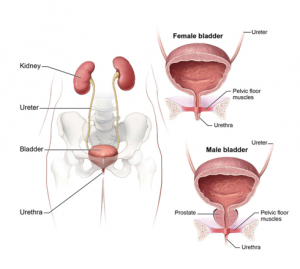What is a catheter?
How is a catheter inserted?
Taking care of your catheter:
Taking care of your urine bags:
Other useful information about your catheter:
Having a catheter for a shortterm:
Having a catheter for a longer term:
Minimising the risk of infection:
Daily life with your catheter:
Potential problems associated with having a catheter in place:
What is normal bladder function?
This means being able to voluntarily pass urine in a socially acceptable place. Urine is produced by the kidneys. It then passes down two tubes (the ureters) into the bladder, where it collects.
As the bladder fills, the person feels the urge to urinate. The bladder muscles then contract, allowing urine to pass from the bladder, down the urethra, to the outside of the body.
However, this process does not always work properly. There may be many different reasons for this, such as:
- Before or after surgery of the bladder, prostate or other areas of the urinary tract
- Spinal cord injury
- Parkinson’s disease
- Stroke
- Multiple sclerosis
- Spina bifida
- Other medical conditions.
What is a catheter?
A catheter is a narrow, flexible, hollow tube that is introduced into the bladder, via the urethra. Its purpose is to allow the free drainage of urine. It is held in place by a small balloon at the catheter tip, inside the bladder. The balloon is inflated with a few millilitres of water.
As the bladder fills with urine, it drains down through the catheter and into the bag. You do not need to go to the toilet to pass fluid when you have a catheter in place.
Your doctor will determine how long your catheter needs to be left in for. If your doctor recommends your catheter remain in place for a longer period of time, it may need to be changed periodically. You will be advised accordingly.
How is a catheter inserted?
An indwelling catheter is introduced either via the urethra or via a surgical opening in theabdominal wall, called a suprapubic site.
Taking care of your catheter:
Always wash your hands with warm, soapy water and dry them well, both before and after handling your catheter and drainage bags.
- Clean the area around your catheter with mild soap and water and pat dry, morning and night, and after opening your bowels. Avoid high pH soaps, as they may cause irritation to the site
- Do not use powders, deodorants or creams around the catheter or suprapubic site
- Anchor the catheter to your skin to avoid pulling
- Always keep the bag below bladder level, to ensure good drainage and prevent backflow. Avoid kinking in the tubing
- Avoid disconnecting your leg bag from the catheter, other than for routine bag changes (even with showering), as this can increase your risk of infection.
Taking care of your urine bags:
You will have been provided with two types of bags: the leg bag and the night bag.
The leg bag:
- Is a sterile bag
- Should always stay connected unless it is being changed (usually weekly)
- Is worn under normal clothing, and is usually attached to your leg above your knee with a pair of straps
- Should be strapped securely to prevent trailing or dragging on the catheter
- Should be emptied into the toilet when it is just over half full, or every 2 hours
- Should not be allowed to become more than ¾ full.
The night bag:
- Is attached directly over the leg bag for overnight use
- Holds more urine so that you do not have to get up overnight to empty it.
To attach the night bag:
- Wash and dry your hands
- Empty the leg bag into the toilet
- Do not remove the leg bag from the catheter
- Check that the night bag outlet is closed
- Attach the night bag outlet to the outlet of the leg bag
- Open the leg bag outlet
- Wash and dry your hands
- Hang the night bag over the side of the bed or sit it in a clean bucket at the side of the bed
- Do not lay the bag on the floor, because it may increase the risk of infection.
In the morning:
- Wash and dry your hands
- Carefully pull apart the night bag from the leg bag
- Close the outlet on the leg bag
- Clean your night bag daily and reuse. Replace it weekly.
To clean the night bag:
- Run warm, soapy water into the bag. A small funnel can be useful
- Do not use strong detergents or sterilizing agents (such as Milton or bleach) because they can damage your bag and can cause irritation to your urethra, bladder and skin
- Wash the bag out, then rinse well with water
- Adding a tablespoon of white vinegar into the final rinse can help with controlling any odour
- Hang the bag up to dry completely
- The night bag should be discarded weekly and replaced
- The old bag should be wrapped in two plastic bags and disposed of in the rubbish bin
- Wash your hands thoroughly.
Weekly changing of the leg bag:
- Wash and dry your hands
- Empty the leg bag into the toilet
- Holding the catheter firmly in your hand, carefully disconnect the leg bag from the catheter
- Connect the new sterile bag onto the catheter, ensuring that you DO NOTTOUCH the end that you are inserting into the catheter
- Make sure the outlet is closed on the leg bag
- Strap the new leg bag securely to your leg
- The old bag should be wrapped in two plastic bags and disposed of in the rubbish bin
- Wash your hands thoroughly.
Other useful information about your catheter:
Aim to drink at least 2L of fluids per day (unless your doctor has instructed you to restrict your fluid intake for other medical reasons).
Eat a well-balanced diet that is high in fibre, to prevent constipation. Constipation can cause your catheter to bypass (leak) and can increase the chance of developing a urinary tract infection.
Stay as mobile as you can and change your body position regularly.
Having a catheter for a shortterm:
If you are only expected to have a catheter in place for a few weeks, and you are comfortable with self-management of your catheter care, you will be provided with an appointment for removal and trial of void either before you are discharged or within a week of being discharged from hospital.
If you require follow up for the management of your catheter care, the ward staff will make the appropriate arrangements for a nurse from Bolton Clarke (formerly Royal District Nursing Service) to assist you in the community.
If you fail your trial of void (unable to urinate after removal of catheter), you will be provided with additional supplies to last a few more weeks, and an appointment will be scheduled for you to see your urologist.
Having a catheter for a longer term:
If your catheter is being placed for the longer term, or permanently, you will be referred either to the Bolton Clarke nurse or your GP to assist you in arranging ongoing supplies and to schedule your catheter changes at 6-12 weeks.
Minimising the risk of infection:
Personal hygiene is extremely important when you have a catheter inserted.
The most common problem with having a catheter in place is urinary tract infection. This can occur when bacteria enters the bladder via the catheter.
- Always wash and dry your hands before and after handling the catheter
- Wash around the catheter with a soft, damp cloth, wiping in downward strokes away from the site, then wash the area where the catheter enters the body- this needs to be done at least twice daily, or more frequently if there is any discharge
- Men should pull back the foreskin carefully to wash underneath, remembering to replace the foreskin immediately
- Women should wipe from the front to the back, to prevent contamination
- Do not use strong soaps, powders, creams, antiseptics, bubble bath or anything else around the catheter.
Daily life with your catheter:
Having a urinary catheter does not prevent you from having a social life or from participating in leisure activities.
Intercourse with a urinary catheter is possible.
- Before intercourse, both partners should wash and dry their genitals thoroughly
- Do not remove your catheter, unless you have been instructed to do so by your doctor or nurse
- Men can fold the catheter down along the side of the erect penis, and hold it in place with a condom
- Women can tape their catheter up onto the abdomen using surgical tape; ensure that it is not pulled tight
- Avoid rough intercourse
- Use water-soluble lubricants only, such as KY Jelly
- DO NOT use petroleum jelly, such as Vaseline
- After intercourse, both partners should wash and dry their genitals again.
If you experience any problems, please speak to your doctor or nurse. Please do not feel embarrassed to ask them, because they are there to help you.
Potential problems associated with having a catheter in place:
- Bladder cramps
- Not uncommon, especially when the catheter is first inserted
- Generally settle within a couple of days
- Paracetamol can help to ease discomfort
- If they do not settle, or are accompanied by other symptoms (below), contact your urologist or continence nurse.
- Discoloured or strong-smelling urine
- Usually an indicator of dehydration
- Aim to drink a minimum of 2L water and fluids per day.
- Urinary tract infections
- Signs may include:
- Cloudy, bloody, or smelly urine
- Feeling unwell
- Fevers, chills, or shaking
- Bladder, lower back, pelvic or flank pain
- Signs may include:
If you have any of the symptoms above, please arrange to see your doctor as soon as possible.
- No drainage from the catheter
- Is the tube bent or kinked? Make sure the tube can flow freely
- Is the bag below bladder level? Make sure the bag is lower than your bladder
- Is there sediment in the bag that is blocking the tubing? Speak to your doctor or nurse
- Have you been drinking enough? Aim for at least 2L daily
- Have you been sedentary? Try getting up and moving around
If no urine has passed in 4 hours, contact your doctor.
- Leaking around the catheter
- This is not serious, but if it persists, report it to your doctor or continence nurse.
If your catheter falls out, you must contact your continence nurse or doctor immediately. You may be advised to head to your nearest hospital for assistance.
